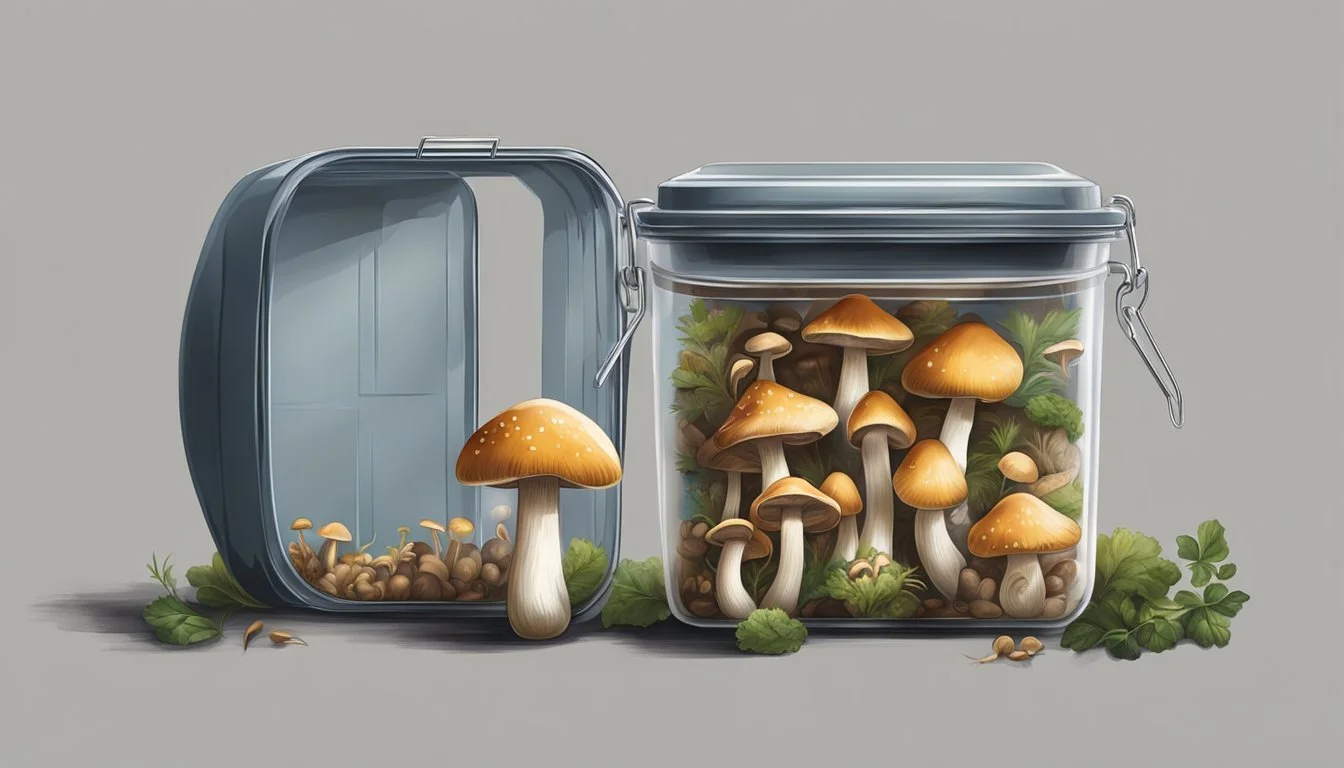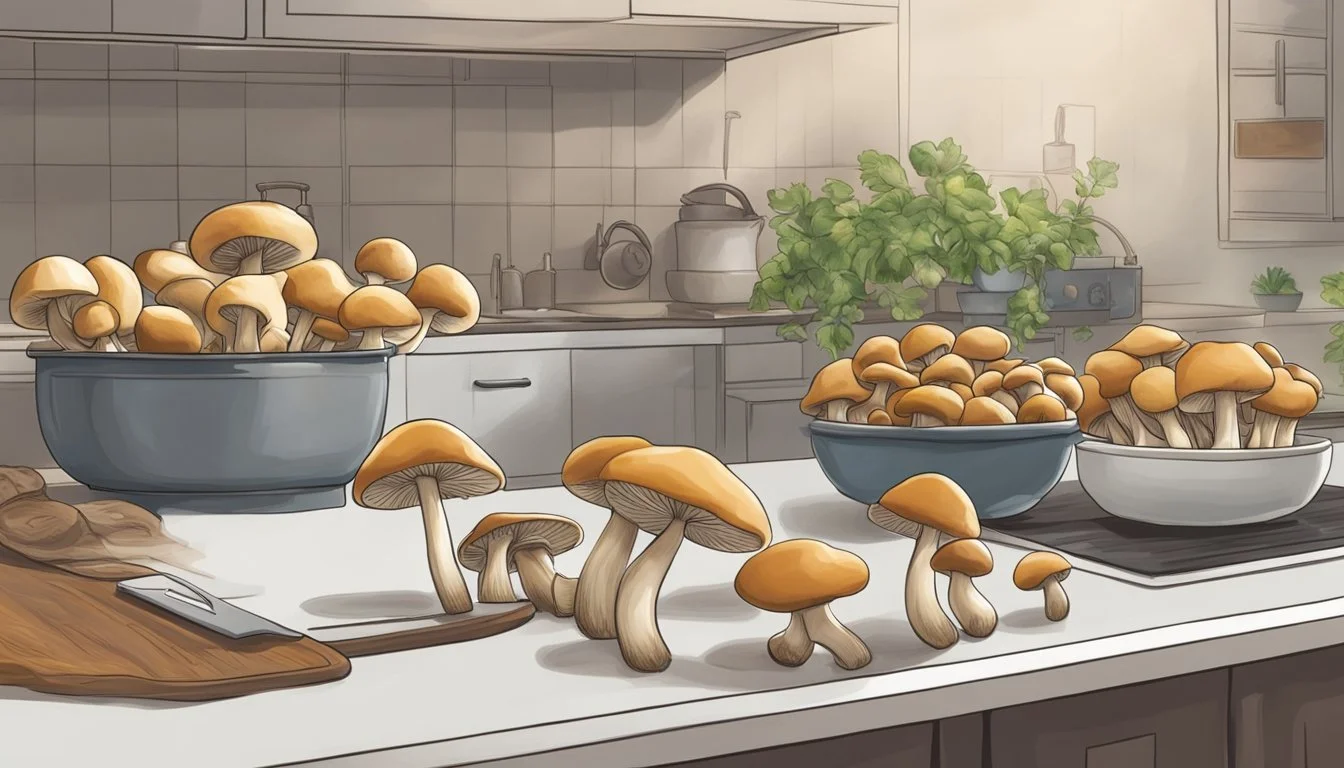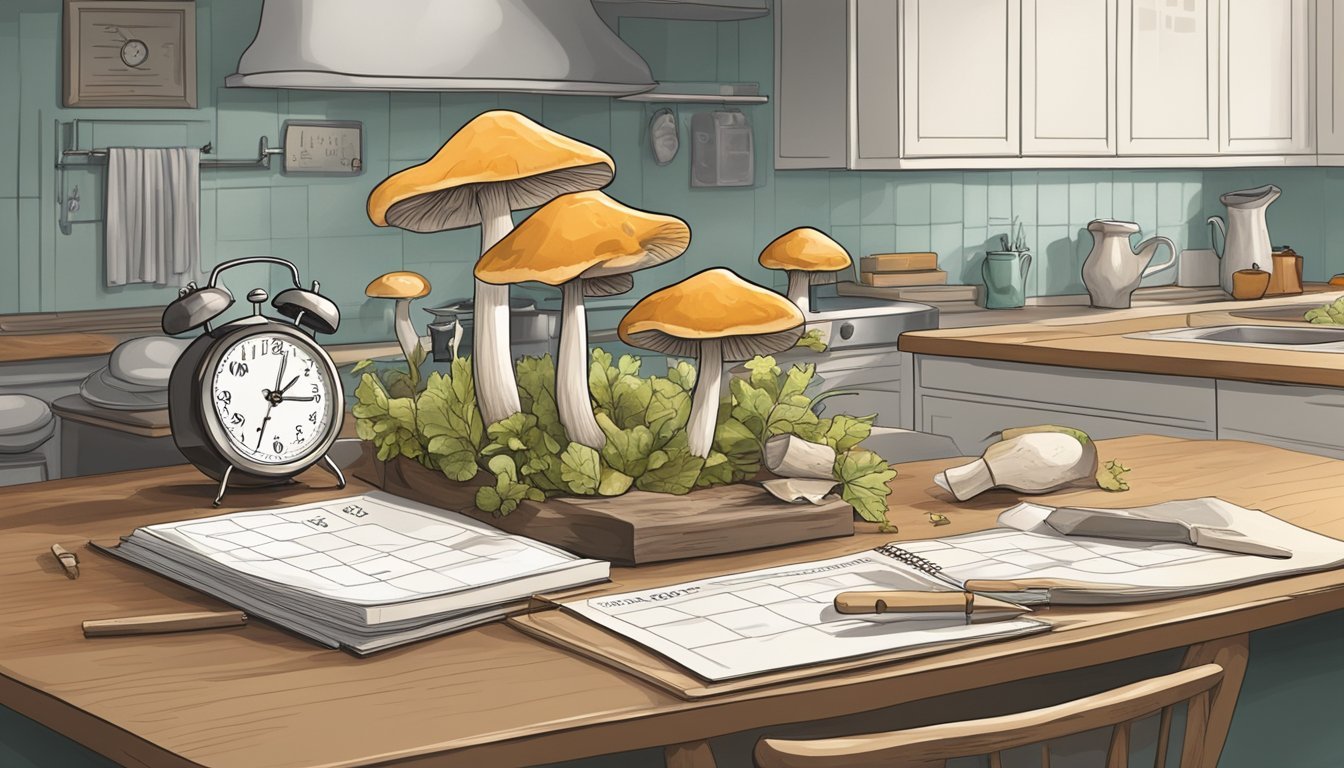How Long Do Mushrooms Last?
Shelf Life and Storage Tips
Mushrooms (What wine goes well with mushrooms?) are a versatile and nutritious addition to any diet, but their shelf life is a subject of careful consideration for both chefs and consumers. Fresh mushrooms typically last for up to one week in the refrigerator when stored correctly. To prolong their freshness, mushrooms should be kept in their original packaging or placed in a brown paper bag which helps to absorb excess moisture. It's essential to keep them unwashed until use to prevent spoilage.
Certain factors influence the longevity of mushrooms, including the mushroom species, the temperature and humidity of the fridge, and whether the mushrooms are sliced or whole. While whole mushrooms can last up to two weeks, pre-sliced varieties tend to have a shorter lifespan of about five to seven days due to increased exposure to air and moisture. Additionally, cooked mushrooms can be refrigerated and safely consumed for a few days longer than their raw counterparts.
Proper storage techniques can extend the useful life of mushrooms even further. For instance, freezing is an option that keeps mushrooms safe for consumption for several months. Meanwhile, drying mushrooms effectively removes moisture, granting them an extended shelf life of up to a year without significant loss of flavor or texture. Recognizing the signs of spoilage, such as a slimy texture, unpleasant odor, or dark spots is crucial to ensure the mushrooms are consumed when they are at their best quality.
Understanding Mushrooms
Mushrooms have varying shelf lives depending on their type and form, such as fresh or dried, and they are valued for their nutritional contribution to the diet.
Types of Mushrooms
There are numerous varieties of mushrooms, each with specific characteristics that affect their longevity. Fresh mushrooms, like common button, portobello, and shiitake, typically have a shorter shelf life than dried mushrooms. Fresh mushrooms may last for a week up to two weeks when stored properly in a refrigerator, while dried mushrooms can last up to a year in a cool, dry place.
Nutritional Value
Mushrooms are a low-calorie food rich in vitamins and minerals. They offer a unique nutritional profile as they contain vitamin D, which is not widely available in plant-based foods. Additionally, they are a good source of B vitamins, including riboflavin, niacin, and pantothenic acid, and provide essential minerals like selenium, potassium, and copper. The conservation of these nutrients depends on the proper storage and handling of both fresh and dried mushrooms.
Mushroom Shelf Life
The shelf life of mushrooms greatly depends on various factors, with distinct differences between fresh and dried varieties.
Shelf Life Determinants
The lifespan of mushrooms is influenced by several key environmental and handling factors. Temperature, humidity, and exposure to air play crucial roles in determining longevity. Proper storage is vital, with lower temperatures and controlled humidity levels contributing to extended shelf life. Canned mushrooms, when unopened, may last for 3 to 5 years. However, once opened, the shelf life decreases considerably.
Fresh vs. Dried Lifespans
Fresh mushrooms typically last 1 to 2 days at room temperature and about 4 to 7 days in the refrigerator. They have a high water content, making them susceptible to spoilage. To extend their shelf life, fresh mushrooms can be frozen, lasting between 9 to 12 months in the freezer.
On the other hand, dried mushrooms have a much longer shelf life. When stored in a pantry, and making sure the environment is cool and dry, they can last up to a year. For a significantly extended lifespan, dried mushrooms can be stored in the freezer where they can remain viable for up to 2 years.
Storage Method Fresh Mushrooms Lifespan Dried Mushrooms Lifespan Room Temperature 1-2 days Up to 1 year Refrigerator 4-7 days Not recommended Freezer 9-12 months Up to 2 years
Safely Storing Mushrooms
Proper storage is crucial for keeping mushrooms fresh and extending their shelf life. The longevity of mushrooms can be maximized by understanding the nuances of refrigerator, freezer, and dry storage.
Refrigerator Storage
Fresh mushrooms should be kept in the refrigerator where they can last for up to a week. Storing mushrooms in a brown paper bag is recommended, as it absorbs excess moisture and allows for some air circulation. The bag should be folded over and placed in the main compartment of the refrigerator, not the crisper drawer where moisture levels are higher.
Container: Alternatively, mushrooms can be stored in a breathable container or zip-top bag with a paper towel inside to soak up moisture.
Air Circulation: It's beneficial to open the container every few days to release carbon dioxide and let in fresh air.
Freezer Storage
To freeze mushrooms, one should first cook them since raw mushrooms do not freeze well. A quick blanche in boiling water or sautéing in a pan is suitable.
Pre-Treatment: A solution of 1 pint of water and 1 teaspoon of lemon juice can be used to maintain the color of the mushrooms post-freezing.
Freezing Method: Once cooled, the cooked mushrooms should be placed in an airtight freezer-safe bag or container and can be stored in the freezer for up to 12 months.
Dry Storage
Drying mushrooms is an efficient way to preserve them for an extended period. One must ensure the mushrooms are thoroughly dried to prevent spoilage.
Temperature and Humidity: The ideal conditions for air drying mushrooms are within the temperature range of 60-70°F and a humidity level between 55-65%.
Storage: After drying, mushrooms should be stored in an airtight container in a cool, dark place to maintain their quality.
Identifying Spoilage
When checking mushrooms for spoilage, one should examine their visual appearance, smell, and texture for any telltale signs of degradation. The following subsections provide specific details to help determine if mushrooms have gone bad.
Visual Indicators
Mushrooms exhibiting dark spots or unexpected discoloration may be a sign of spoilage. Fresh mushrooms have a uniform color, and any notable deviations could suggest the onset of mold or bacteria. One should also look for the presence of mold, which can appear as fuzzy spots in various colors such as white, green, or black.
Olfactory Signs
A strong or noticeable odor is a clear indication that mushrooms may have spoiled. Fresh mushrooms typically have a light, earthy smell, which should not be overpowering. An unpleasant or sour smell is a sign that the mushrooms should be discarded.
Texture Changes
Mushrooms that have become slimy to the touch are past their prime and should not be consumed. Sliminess often occurs when bacteria begins to break down the mushroom's flesh, leading to a loss of freshness and possible exposure to harmful microbes. The texture of mushrooms should be firm, not slick or slippery.
Extending Mushroom Freshness
Mushroom freshness can be significantly extended through effective drying, dehydrating, canning, and pickling methods. Each approach minimizes moisture content, which is critical in preventing spoilage.
Drying and Dehydrating
Drying mushrooms is a reliable method for extending their shelf life. Mushrooms should be cleaned and sliced thinly to ensure even dehydration. Using a food dehydrator at low temperatures can preserve mushrooms effectively, generally for 6-12 months. This process removes the majority of the water content, inhibiting bacterial growth.
Steps:
Clean mushrooms with a brush or dry paper towel.
Slice mushrooms thinly.
Lay the slices on the food dehydrator tray.
Set the dehydrator to 135°F (57°C) and let it run for 4 to 8 hours.
Store the dried mushrooms in an air-tight container with a desiccant like silica gel to absorb any residual moisture.
Canning and Pickling
Canning and pickling are additional preservation methods that can extend the shelf life of mushrooms. When properly sealed, canned mushrooms can last for years, while pickled mushrooms maintain their flavor and quality for several months. The key is ensuring a sterile environment during the canning process to prevent contamination.
Canning Process:
Sterilize jars and lids.
Blanch or boil mushrooms in water or a vinegar solution.
Pack mushrooms into jars and cover with the pickling brine or sterilized water.
Apply lids and process jars in a boiling water bath or pressure canner according to safe canning guidelines.
Pickling Brine:
Combine equal parts water and vinegar.
Add salt and preferred spices.
Bring the mixture to a boil.
Using these methods, consumers can enjoy mushrooms well beyond their typical fresh lifespan, ensuring less food waste and more availability throughout the year.
Using Mushrooms in Cooking
Incorporating mushrooms into recipes adds depth and umami to dishes. Selecting the right type and preparing them correctly are key to maximizing flavor and texture.
Selecting Mushrooms for Recipes
When choosing mushrooms for cooking, it's important to consider the type that best suits the dish. Button, cremini, and portobello mushrooms are versatile and commonly used in a variety of recipes such as sauces, soups, and as pizza toppings. (What wine goes well with pizza toppings?) They provide a meaty texture and a rich, earthy flavor that enhances the overall taste of the dish. For recipes that require a delicate, subtle flavor, oyster or shiitake mushrooms are preferable. They should be firm to the touch, free from spots and blemishes, and not exhibiting any signs of slime, which indicates spoilage.
Button mushrooms: Mild flavor; ideal for salads and general cooking.
Portobello mushrooms: Robust taste; great for grilling and stuffing.
Shiitake mushrooms: Woodland flavor; suitable for Asian-inspired dishes.
Preparation Techniques
Proper preparation techniques are crucial for cooking mushrooms to maintain their texture and flavor. Mushrooms should be cleaned gently with a damp cloth or a soft brush to remove any dirt. They can be sliced to various thicknesses depending on the cooking method; however, thicker cuts are recommended for soups, stews, and baking to offset shrinkage during cooking.
When cooking mushrooms, they require ample space in the pan to avoid steaming and to ensure they become nicely browned. Cooking them with ingredients like garlic can significantly enhance their umami quality. To retain moisture and prevent drying out, mushrooms should be cooked until they release their natural liquids and these liquids evaporate, leaving the mushrooms with a concentrated flavor and desirable texture.
Cleaning: Wipe with a damp cloth or brush; avoid soaking in water.
Slicing: Cut to ½ inch thickness for most cooking methods.
Cooking:
Sauté over medium heat until golden.
Use garlic for added flavor.
Avoid overcrowding the pan.
By selecting the appropriate mushrooms for the recipe and applying the correct preparation techniques, chefs can ensure that the cooked mushrooms will contribute significantly to the success of their culinary creations.
Special Considerations
When preserving the quality and extending the lifespan of mushrooms, two effective methods involve freezing and refrigerating cooked mushrooms. Each method has its optimal practices to maximize shelf life.
Freezing Mushrooms
Freezing uncooked mushrooms is less ideal, as it can alter their texture, but they can be kept in the freezer for an extended period. To freeze mushrooms:
Clean them by dusting off any dirt.
Slice if desired, or leave whole.
Blanch in boiling water for 1-2 minutes.
Plunge them into ice water to halt the cooking process.
Drain thoroughly and pat dry.
Spread them out on a baking sheet to freeze individually.
Once frozen, transfer to airtight containers or freezer bags.
Frozen mushrooms can last from 2 to 12 months. Labeling with the date of freezing helps track how long they've been stored.
Refrigerating Cooked Mushrooms
Cooked mushrooms should be promptly stored in the refrigerator to maintain their quality. They should be kept in an airtight container to prevent them from absorbing other flavors and moisture. Shelf life of cooked mushrooms in the refrigerator typically ranges from 3 to 5 days. It's important to allow the cooked mushrooms to cool before refrigerating to prevent moisture buildup, which can hasten spoilage.
Health and Safety
When it comes to mushrooms, understanding the health and safety aspects is critical. The key points to consider for safety include allergenic responses and the steps necessary to prevent foodborne illnesses.
Mushrooms and Allergies
While mushrooms are generally safe to eat for most individuals, they can cause allergic reactions in some. Symptoms may include skin rashes, itching, or respiratory issues. It's essential for someone with mushroom allergies or sensitivities to avoid both raw and cooked mushrooms, as well as cross-contamination with other foods.
Preventing Foodborne Illness
Handling and Storing: Proper handling and storage are vital in preventing foodborne illness. Raw mushrooms should be refrigerated and consumed within 5-7 days to maintain quality and safety. Canned mushrooms have a longer shelf life but should be used within a few days once opened, and up to two months if properly frozen.
Cooking and Preparation: Cooking mushrooms can kill harmful bacteria, and a pressure cooker can be used to effectively sterilize canned mushrooms to prevent contamination. It’s important to cook mushrooms to an internal temperature high enough to kill potential pathogens.
Spoilage Indicators: Moldy mushrooms are a clear indicator of spoilage. The presence of mold suggests high water content, providing an optimal environment for mold and bacteria growth. Discard mushrooms showing signs of mold or a strong odor as they can lead to foodborne illnesses.
Conclusion
The longevity of mushrooms is influenced by several factors, including their type, how they're stored, and whether they are raw or cooked. Raw mushrooms typically last 7 to 10 days in the refrigerator, while cooked mushrooms can remain good for an additional 3 to 5 days. When freezing, mushrooms can be preserved for 8 to 12 months, but it's crucial to clean them before doing so.
For those who prefer drying, mushrooms can maintain their quality for up to one year when properly dried and stored. It's important to minimize exposure to moisture and air to prolong their lifespan. The table below summarizes the shelf life under different conditions:
Condition Shelf Life Raw in the fridge 7 to 10 days Cooked 3 to 5 days Frozen 8 to 12 months Dried Up to 1 year
To maximize mushrooms' freshness and safety for consumption, one should store them in a dry, dark place within the refrigerator and keep them in their original packaging or a paper bag. By adhering to these guidelines, the quality and flavor of mushrooms are better preserved for use in a variety of dishes.








